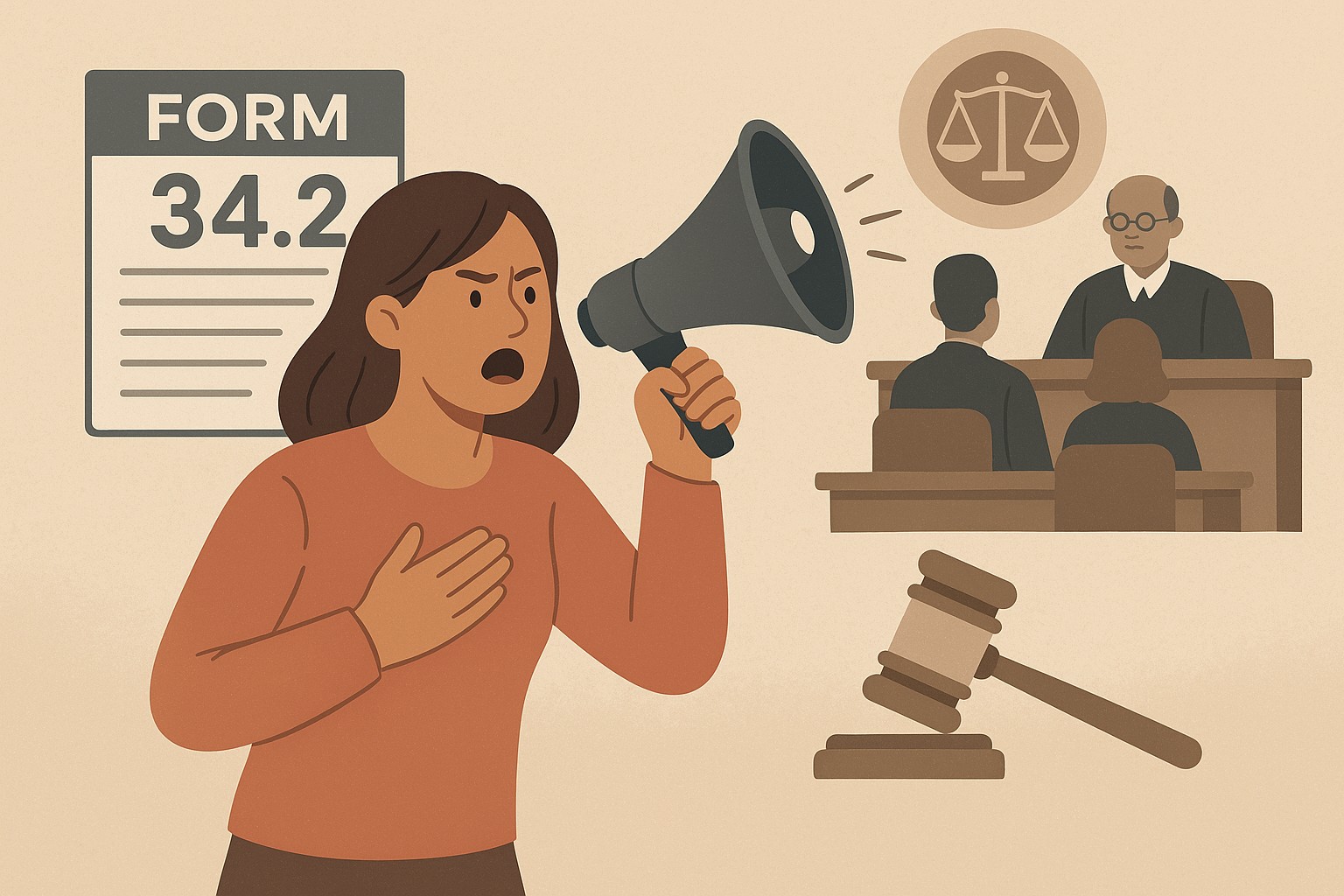A Victim's Guide to Form 34.2: Making Your Voice Heard in Ontario Courts
After a conviction in a criminal case, your voice matters. The **Victim Impact Statement (Form 34.2)** is your official opportunity to tell the court, in your own words, how the crime has affected your life physically, emotionally, and financially before the offender is sentenced. Our guide explains the step-by-step process of writing and submitting your statement in Ontario, including how to request a Restitution Order for your financial losses.

The Criminal Code Form 34.2 – Victim Impact Statement (VIS) is your opportunity to speak directly to the court after an offender has been found guilty but before they are sentenced. It is your voice.
While the trial focuses on proving the facts of the crime, the Victim Impact Statement ensures the judge understands the full human consequences. It’s your chance to describe, in your own words, how the crime has affected your life—physically, emotionally, and financially.
This guide explains the purpose of the VIS, how to write it, and the process for submitting it in Ontario.
What is a Victim Impact Statement?
A Victim Impact Statement is a written account that describes the harm or loss you have suffered as a result of a crime. It is not about describing the crime itself (the court knows these facts from the trial) but rather the aftermath. It is a formal, legal document that becomes part of the court record.
Presenting a VIS is your right, but it is not an obligation. You can choose whether or not you wish to prepare one.
Why Your Statement Matters
The VIS is a powerful tool for several reasons:
-
It Informs the Judge: It helps the judge understand the real-world impact of the offender's actions when they are making sentencing decisions.
-
It is a Path to Restitution: It is the primary way to ask the court to order the offender to pay you back for financial losses you suffered because of the crime (a Restitution Order).
-
It Can Be Part of Healing: For many victims, giving a statement is a way to have their experience acknowledged by the justice system, which can be a powerful and validating part of the healing process.
The Process: How to Create and Submit Your VIS in Toronto
Step 1: Getting the Form
After an offender is found guilty or pleads guilty, the police or, more commonly, the Victim/Witness Assistance Program (VWAP) will provide you with Form 34.2. The VWAP is a crucial resource based in Ontario courthouses that provides support and information to victims and witnesses.
Step 2: Writing Your Statement
Take your time with this. You can write it yourself or ask for help from a support person or a VWAP worker. The form is divided into three main sections:
-
Emotional Impact:
-
Describe how the crime has affected you psychologically. Consider prompts like:
-
How has this affected your daily life, your relationships, or your ability to work or go to school?
-
Have you experienced fear, anxiety, depression, or trouble sleeping?
-
Has your sense of safety and security been impacted?
-
-
-
Physical Impact:
- Describe any physical harm you suffered. This includes everything from injuries that have healed to long-term disabilities, scarring, or ongoing pain. You can attach photos or medical reports if you wish.
-
Financial Impact (Requesting Restitution):
-
This section is critical if you have lost money because of the crime. Be as detailed as possible and keep your receipts. You can request restitution for costs such as:
-
Lost wages from time off work for medical appointments or court dates.
-
Medical expenses not covered by insurance (e.g., physiotherapy, dental work).
-
Counselling or therapy costs.
-
The cost to repair or replace damaged or stolen property.
-
The cost of changing locks or installing a security system.
-
-
Step 3: Choosing How to Present Your Statement
You have several options for how your statement is presented to the judge:
- Read it Aloud in Court: You can choose to read your statement yourself during the sentencing hearing.
- Have Someone Else Read It: If you prefer not to speak, you can have a support person, family member, or the Crown Attorney read it on your behalf.
- Present it in Another Way: With the court's permission, you could present it via a pre-recorded audio or video statement.
- File it with the Court: If you do not want it read aloud, you can simply submit the written statement. The judge is required by law to read and consider it.
Step 4: Submitting the Completed Form
Once your statement is complete, you will give it to the VWAP worker or the Crown Attorney assigned to your case. They will ensure it is properly filed with the court before the sentencing hearing.
Important Things to Remember
-
Focus on the Impact: The statement is about the effect the crime had on you.
-
Do Not Give an Opinion on the Sentence: Do not suggest what punishment the offender should receive (e.g., "I think they should go to jail for five years."). This is the judge's role.
-
Do Not Insult the Offender: Stick to describing the impact of their actions.
Help is available. You do not have to do this alone.
Local Resources & Disclaimer:
-
Victim/Witness Assistance Program (VWAP): This program is available in every criminal courthouse in Ontario and is your primary source of support.
-
Toronto Victim Services: A community-based organization providing 24/7 crisis response and support.
-
This guide provides general information and is not legal advice. The VWAP and the Crown Attorney can provide guidance specific to your case.
